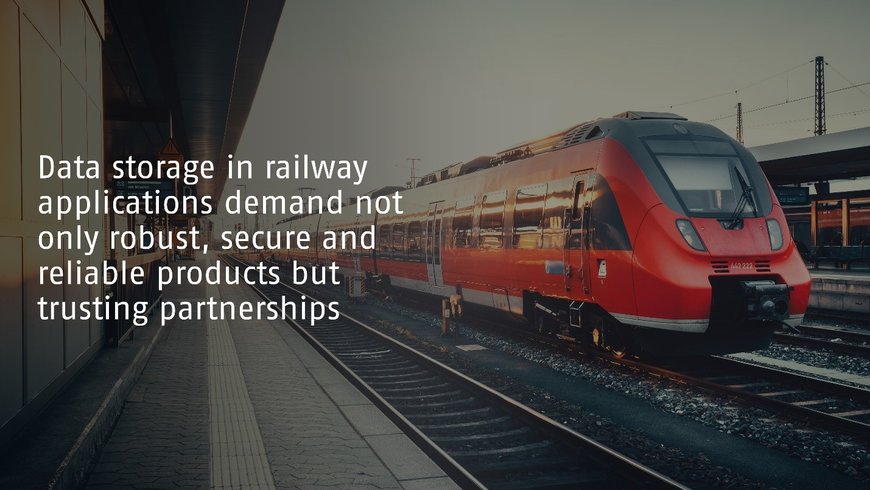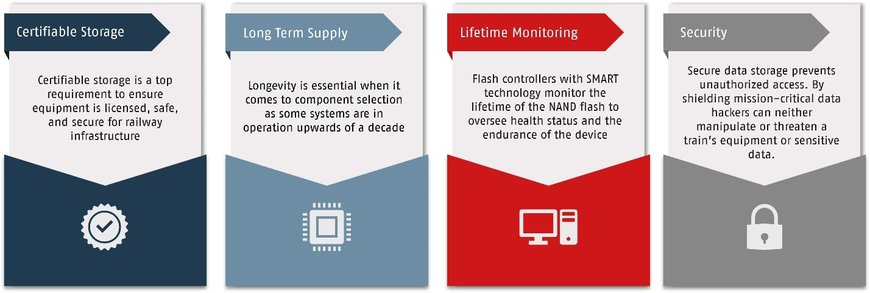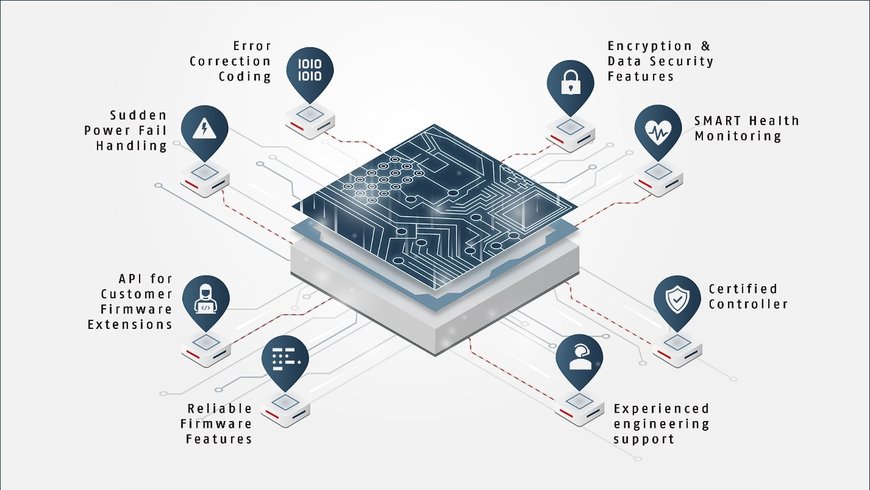www.industry-asia-pacific.com
30
'23
Written on Modified on
Hyperstone brings Reliable Data Storage for Railway Applications
Particularly, in railway applications reliable storage is essential, where even small faults in security and safety can bring dire consequences.

As such, railway operators, locomotive manufacturers, and infrastructure suppliers must work with partners who they can trust to provide proven, reliable, and safe onboard electronics. Moreover, they need these products to be configurable so they can meet the specific needs of their vehicles and applications over a long period of time.
Why Trains Need Secure Storage
Safety and reliability are key supply chain concerns - and the rail is no exception.
For starters, the very complexity of railway infrastructure presents challenges for safety and reliability. The risk is compounded by a train’s given cargo, which may contain sensitive and/or hazardous materials. And, of course, passenger safety is always a priority. As an integral part of the greater supply chain, a breach of security on the rails can cause a ripple effect of complications across industries.
Ultimately, securing the greater supply chain begins with ensuring safe railway applications. Considering the breadth of equipment aboard trains, this is no simple feat. For example, standard railway equipment can include operating panels, motor controls, monitoring systems and safety instruments and all this equipment requires storage for both the operational system and operational data.
Securing the Event Data Recorder
The event data recorder (EDR) (also called the Juridical Recording Unit (JRU) or, more colloquially, the black box) is one of the most important pieces of equipment aboard a train. The EDR is designed to record information (e.g., vehicle speed, braking, audio and video signals, etc.) the entire time the train is running. Importantly, this data collection can never be interrupted, even by the flash controller as it performs internal management functions. In addition to real-time data collection, the EDR must also reliably save all this data and keep it secure in the event of a power failure.
EDRs are primarily designed for safety purposes. By recording and storing all the train’s pertinent data, they serve as an important resource during investigations of railway accidents. Railway teams also use EDRs for system monitoring, which, in turn, helps reduce maintenance, avoid downtime, and improve overall efficiency.
As EDRs play such a significant role in both passenger safety and system security, they are considered a mission-critical application and, thus, come with strict requirements. Not only must they be resistant to physical damage, interference from magnetic fields, water, and other environmental hazards, but they must also provide rugged, robust, and reliable computing and storage.
Top Requirements for Electronic Railway Applications
EDRs are just one example of electronic railway applications, but they make clear the gravity of these safety-critical applications and just how important their secure storage is.
To ensure safe operations for both passengers and the supply chain at large, railway infrastructure must comprise storage that is reliable, maintainable, and predictable.
To that end, electronic railway applications require:
● Certifiable storage
● Long-term supply of components
● Lifetime monitoring
● Security from outsider attacks

Certifiable Storage
For all critical railway applications (such as EDRs, motor controls, and operating panels), certifiable storage is a top requirement. Eligible for approval by government authorities’ certifiable storage gives both infrastructure suppliers and train manufacturers the power to ensure their equipment is licensed, safe, and secure for railway infrastructure and all railway undertakings. For this reason, the selection of electronic components making up a given storage device should be certified and of high quality.
Long-Term Supply of Components
When it comes to railway infrastructure, most systems are in use for upwards of 10 years. As such, an important aspect of storage for railway applications is longevity. Only with guaranteed long-term access to essential components can railway companies keep up with needed maintenance throughout the entirety of the system’s lifetime.
A long-term supply of components is, thus, vital for ensuring long-term infrastructure health. Ultimately, it is not just cutting-edge technology that railway companies depend on but appropriate after-sales service that can remain reliable throughout the lifetime of the system.
Lifetime Monitoring
Storage designed for longevity needs SMART technology to monitor the system’s lifetime to ensure quality. While the EDR monitors the trains behavior, the right NAND flash controller integrated within a storage system can monitor the lifetime of the storage, the ‘NAND flash’ through Self-Monitoring, Analysis and Reporting Technology (SMART) technology.
Flash controllers with SMART technology monitor the lifetime of the NAND flash device using different attributes. For example, spare blocks, erase counts, total number of reads and ECC errors can be counted, and the lifetime can be estimated accurately.
This lifetime monitoring provides information about the health status and the endurance of the NAND flash within a storage device and allows those responsible to maintain an overview of their operations and identify the best possible time to trade out a storage device within a given system (e.g., EDR) before the NAND flash inevitably reaches its expiry date.
Security from Outsider Attacks
Finally, it goes without saying that security from outsider attacks is of the utmost concern for all electronic railway applications. Only with reliable and secure data storage can companies protect the railway, passengers, goods, and the supply chain.
For example, robust data storage helps prevent unauthorized access to data. By shielding mission-critical data from outsiders, secure data storage ensures that hackers can neither manipulate nor threaten a train’s equipment or sensitive data.
How Flash Memory Delivers the Data Security Railways Need
Railway applications have steep requirements for reliable, robust and secure data storage. This leaves locomotive manufacturers and infrastructure suppliers searching for solutions that they can trust to provide proven and safe onboard electronics. Flash memory is ideally suited to deliver the robust, reliable, and rugged data security that railways applications need.
There are many reasons why flash memory is ideal for applications like EDRs, dashboards, and safety instruments. For one, flash memory is non-volatile. Moreover, unlike other forms of storage, like hard disk drives (HDDs), flash memory is not sensitive to mechanical shock or magnetic fields, both of which can be prevalent issues in the rail industry.
The Role of the Flash Controller in Electronic Railway Applications
When it comes down to it, a NAND flash-based storage system’s ability to ensure reliable data storage depends on the quality of the flash controller that’s used. This is why choosing the right flash controller is critical to the overall success of the storage system design. Ultimately, to get high-quality data storage for railway applications, you need a high-end flash controller.
By managing and optimizing the lifetime of the inherently unreliable NAND flash, flash controllers have become the brains behind any storage system and are key to their behavior and reliability

Depending on the overall system requirements, controllers and their accompanying firmware can be optimized for cost, performance, or reliability so when choosing a storage device or designing the storage for any given system, companies should know what flash controller is implemented, its feature-set and how it has been optimized to best support the selected NAND flash.
Those designing storage should also consider using a flash controller that can provide advanced protection against unexpected power loss. This is always an important feature for storage systems but is particularly crucial for the rail industry. For example, a high-end flash controller can monitor supply voltages; should they fall below a critical threshold, all pending data is immediately written to the NAND flash. For EDRs and other safety-critical railway applications, this feature is vital as it ensures critical data is always protected, even in conditions of extreme stress.
A Reliable Partner for Railway Storage
At the end of the day, ensuring reliable storage for railway applications begins with finding a trustworthy and competent partner. As railway infrastructure poses unique challenges electrically, mechanically, and thermally, only ultra-rugged, power-fail safe solutions that offer the highest data-retention can meet the demanding needs of this industry.
The X1 NAND flash controller from Hyperstone is uniquely designed to fully satisfy these industrial requirements. Secure, reliable, and low power, the X1 is a secure turnkey solution for railway applications, with encryption as well as the possibility to add custom firmware extensions and additional security features through the company’s API.
Reliable data storage is the key to ensuring success in electronic railway applications and, consequently, safety in both rail infrastructure and the overall supply chain—and it all begins with choosing the right flash controller.
www.hyperstone.com

